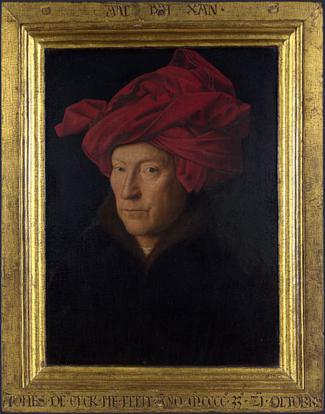Jan van Eyck, also known as Johannes de Eyck, created this masterpiece which is known to be one of the greatest portrait paintings in the world. He was born in Maaseik, Belgium circa 1395, with no exact date of birth since only little was discovered about his younger years. Jan van Eyck was a Flemish artist who mastered oil painting during the period when such art was still a new discovery. Because he was a pioneer master of the art, Jan van Eyck was conventionally known to be the Father of Oil Painting. And with his very truthful paintings of the human form and mastery of the oil techniques, he was also considered as one of the best portraitists of Northern Europe in the 15th century. It is also believed that the artist Hubert van Eyck and the assumed artist Lambert van Eyck are his brothers.
The Portrait of a Man in a Red Turban was made by van Eyck in 1433 in an oil on wood panel. It is one of the best representations of Northern Renaissance of the 15th century, the era which marks the remarkable growth of fine arts from 1430-1580 in Flanders and Germany.
The portrait was believed to be a self-portrait, but there was no strong evidence to confirm such. However, there is an engraving at the uppermost part of the frame showing a convincing proof that the Man in a Red Turban Portrait is a self-portrait of Jan van Eyck. The writings have Greek letters that read “Als Ich Can” (as I/Eyck can), which is some kind of a spoof citation of the artist’s name. The focus of the man’s gaze in the portrait also implies who the character in the painting is. The caption at the bottom frame shows the artist’s name and date of completion, read as “Jan van Eyck made me on 21 October 1433”. It is significant to note that the writings on the portrait were made to look as though they have been carved rather than painted.
What makes the Man in a Red Turban Portrait so natural is its accurate visual effects and mirror-like gleam, a product of van Eyck’s expert skill in using slight layers of clear color pigments that make for the portrait’s full radiance. A clear example is the effects in the eyes of the man in the portrait. The subtle mixture of white, red, blue, and black colors somehow make the eyes of the man appear so alive. The two eyes of the man also show different focuses, with the right eye somewhat hazy while the left eye evidently defined and concentrated on a certain object. The appearance of the eyes is most probably an effect of van Eyck viewing himself through a mirror; because a person cannot see both eyes the same way when viewing oneself from a specific angle.
Jan van Eyck truly was a master oil painter as he was able to unspeakably show himself in the portrait, in such a way that the strokes of his brush seem to have been made invisible.
Author: Shyxter
